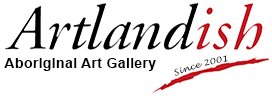Aboriginal Dancing
Traditional dancing is part of the core structure of Aboriginal Tradition. Sometimes called Joonba ( heritage corroboree), Wangka (Festive Corroboree), Munga Munga (women’s corroboree), dancing has from time immemorial to the present day been used by all Australian Aboriginal tribes both for ritual purposes and to express and represent many many facets of their lives and beliefs.
To “own” a particular corroboree is an honour for the Aboriginal people – Joonbas are very often passed down within the family, normally to the eldest of the next generation or to the closest or most deserving relative of the original owner.
Alan Griffiths, a renowned painter who resides in Kununurra, is the Traditional owner of the Bali Bali Balga Joonba, which has been performed many times, for cultural and festive occasions within the Aboriginal calendar and also shared with white people when he and his wife Peggy were invited to organise a performance at the ATSIC Art Awards in Perth. This year, the Joonba was performed in Kununurra as part of the Ord Valley Muster for the Year of the Outback Celebrations. Alan and Peggy make the ornate headboards held by the dancers whilst performing – these were originally woven from pandanus palm leaves and held with bush string – now they are made from colourful wool and braid, but still in the same style as fifty years ago.
Alan’s corroboree extends to his painting – he and Peggy participated in printmaking in Darwin, along with other celebrated artists Rover Thomas, Queenie McKenzie and Jack Britten. Alan’s limited edition prints of his Bali Bali Balga Joonba were a huge success and purchased by Parliament House Collection.
The dancers in Alan’s Joonba paintings are depicted playing boomerangs, singing sticks, digeridoos, dressed with elaborate headwear, inclusive of men, women and children, and the movement, excitement and happiness is very apparent in every work. Alan paints his corroboree in many different ways – sometimes the painting depicts people dancing, singing and playing musical instruments – other times, Alan paints the subject, as he describes it, “with land”. Alan was born at Victoria River Downs just over the border into the Northern Territory, and his tribe would often visit relatives and friends in surrounding country – as far down as Kununurra, with one version of the Joonba titled “Dancing at the Spillway”.
Another corroboree which has now been allowed to be viewed by all Australians is owned by Peggy Patrick, a noted painter, singer and dancer of the Kitja tribe in the Kimberley. This corroboree was passed on to Peggy by her late full brother Timmy Timms, Chairperson of Bow River Station. Peggy and her niece Mona Ramsay (present Chairperson of Bow), and many other invited dancers from their immediate family and friends of the Kitja, Woolah and Jaru tribes, have performed this dance in Perth at the 2002 Arts Festival and recently at the Melbourne Festival in October, titled “Fire Fire Burning Bright”.
The Aboriginal people are happy to show the world their culture by performing these ritual dances as a contemporary multi-media event, although many will be kept “for their eyes only” within their own sacred ceremonies.
Read more about Aboriginal Art Culture

